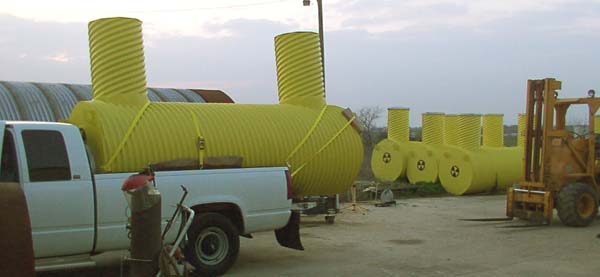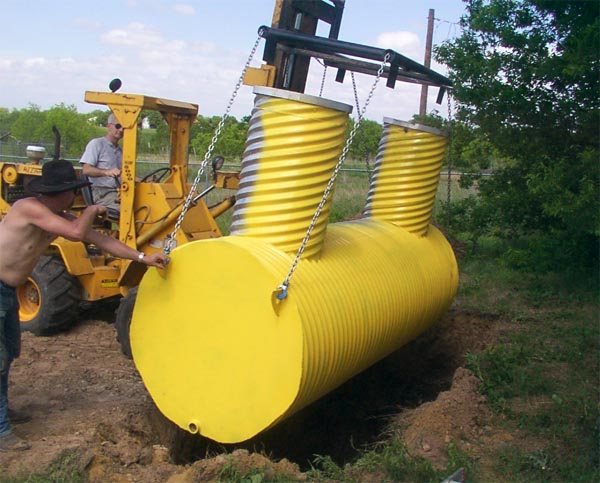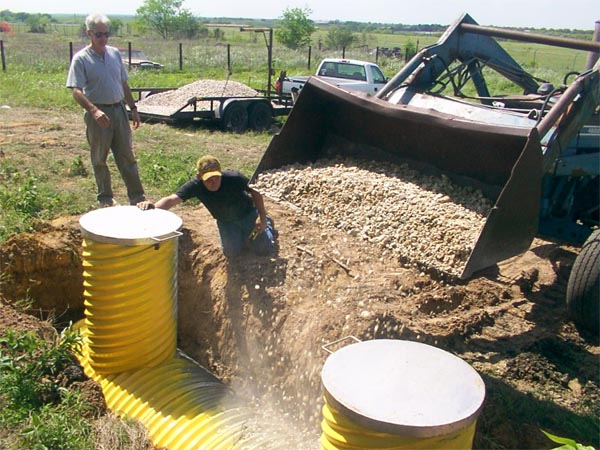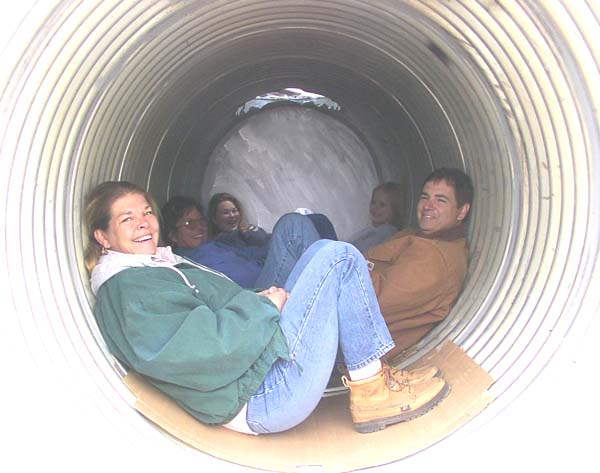|
KI4U, Inc. has been written up in the... NYTimes (6/13/02), Wall Street Journal (3/14/03 & 10/5/01), USAToday (6/11/02 & 7/11/02), Washington Post (4/13/03 & 3/16/03), SF Chronicle (6/23/02), Newsday (11/24/01), WND (1/18/05), IEEE Spectrum (9/01), and National Defense Mag (3/04). And, our products seen on CNN, FOX, CBS and in TIME Magazine and May/June 2004 'Bulletin of the Atomic Scientists' with interviews on 'Coast to Coast' and NPR radio and Glenn Beck's radio show and Glenn Beck's CNN TV Show - 10/12/2006! |
Expedient blast & fallout shelters are, however, perishable. They are constructed of materials,
including wood, which would be generally available in an emergency. Most fallout shelters of this
type become unsafe for occupancy within a few months after construction. Also, expedient blast & fallout
shelters require significant time for construction and therefore might not be available in a
very rapidly developing crisis.
In addition to our standardized designs, there are numerous "do-it-yourself" solutions
that can provide protection on a permanent basis, but most people are deterred from
undertaking such projects which may require substantial skill.
We have been experimenting with a protective fallout shelter that would provide worthwhile
protection on a permanent basis at low cost and with a minimum in comfort and
habitability.
This basic fallout shelter was originally designed by volunteers at Oak Ridge National Laboratory, so in a pending crisis many people could take the simple plans for
the fallout shelter to a local steel fabricator and have it quickly and cheaply built.
This fallout shelter was constructed by a local steel fabricator entirely of new materials and
coated with asphalt for burial for a price of $900. This included about $300 for materials
(primarily steel) and about $600 for labor (primarily welding) and shop expenses and
profit. (1990 pricing, 2003 about $1,500.00, today ?)
It can be buried in a small space by an average family with shovels during their spare
time. This would require about the same amount of digging as does a comparable
expedient shelter. If your family does not want to dig the hole, a small backhoe can do the
job in less than an hour. The shelter weighs about 1000 pounds, so a vehicle might be
needed to drag it into place, although several people can roll and slide it without difficulty.
This fallout shelter would afford fairly good nuclear protection for a cost of about $150 per
person. The shelter stay would be very unpleasant, but brief, and the occupants would likely
survive. It is not at all comparable to a proper civil defense fallout shelter, but it could save the
lives of many Americans in a nuclear emergency.
It does not have air filters for removal of chemical or biological agents. If a fallout shelter of
this type is equipped with the smallest Swiss shelter ventilation system which includes blast
valves, blower, dust filter, and chemical and biological air filters, then the cost rises to
about $400 per person. This would keep the cost per person at a low level for groups of 10
to 15 occupants by placing them in a very small, uncomfortable shelter room. It is
preferable to build a proper shelter for larger numbers of people if this amount of money
per person is available.
The fallout shelter room is a cylinder 46 inches in diameter and 12 feet long, which is fabricated
from two 6 by 12-foot sheets of 10-gauge cold-rolled steel. The ends of the cylinder are
closed by flat plates of the same steel. Six inches from each end, cylinders 24 inches in
diameter and 3 feet long are attached at ninety degree angles to the shelter room to form
two entryways and ventIlation ducts. All seams are welded completely, and the assembled
structure is sprayed with an asphalt coating. An attachment bracket is provided on one
outer end for a protective anode for further corrosion protection.
The family should paint the inside of their shelter with primer and then gloss white
paint. This requires about one-half gallon per coat. Arrange a household fan to suck air out
of one entryway and then paint while backing away from that end. In this way I painted our
test shelter without danger from paint fumes.
A similar structure could be built from corrugated and galvanized pipe, but it would be
much more expensive to fabricate in a water-tight configuration unless mass-produced with
proper tooling. In the case of large scale manufacture, corrugated and galvanized
construction would be preferable.
The fallout shelter doors consist of two circular 1/4-inch steel plates 25 1/2 inches in diameter.
Each plate has a rolled rim made from a 1/4 inch thick steel strip 2 inches wide and 80
inches long. This rim must be welded to the plate inside and out. These caps, when
properly installed and used, provide simple blast doors and valves suitable for blast
overpressures up to 50 psi.
Two small steel loops are welded to the inner surface of each door 6 inches in from the
rim to serve as hinge supports. Four similar loops are welded at 90 degree positions and
two inches down inside each of the 25 l/2-inch entryways. These are positioned at 45
degree angles to the longitudinal axis of the shelter room. The four loops permit water
bottles to be raised into the entryways for additional radiation protection.
Close to each end of the bottom of the fallout shelter room, a 1 inch threaded hole is provided
with threaded plugs which may be removed from inside. During burial, a few Inches of
gravel is placed in a recess under and around these holes. They permit drainage if water
should leak into or be spilled in the shelter. A narrow floorboard may be placed loosely on
the shelter bottom in order to keep the occupants dry if moisture is draining down the
bottom.
Theoretically, this fallout shelter has a fallout protection factor of about 10,000, an initial
nuclear radiation protection factor of about 1,000, and a blast protection capability of
about 50 psi. These are sufficient for most American locations even in a large-scale
nuclear war. In use, given the uncertainties inherent in these severe conditions, it might
degrade to a fallout protection factor of 1000 and blast protection of 25 psi which is still
quIte good. This shelter offers its occupants a good chance of survival of airburst explosions
of most currently deployed nuclear weapons from a horizontal distance of one to two miles,
and it offers good protection from radioactive fallout.
Unlike those in a proper fallout shelter, in case of a near airburst approximately directly
overhead the occupants of this shelter would be killed by initial nuclear radiation. If the
explosion were off toward the horizon, then the initial nuclear radiation protection factor
would be operable.
In use, the fallout shelter must be equipped with 15 one-gallon containers filled with water for
each shelter occupant. A few of these should have handles, because, after the shelter is
occupied, they are to be drawn up into the entryways with cords placed through the four
steel loops. The entryways are thereby partially filled with water for additional radiation
protection.
Expedient ventilation equipment as described in Nuclear War Survival Skills must be
provided. This can be a small Keamy air pump mounted in the rectangular opening of a
cylindrical wooden frame built into the room, or simple expedient fans. The doors are
propped open about 6 inches during shelter occupancy to allow expedient ventilation.
If the direction of an anticipated blast threat is known, then the doors are opened away
from this threat. They may be propped open with small sticks. These sticks would be
crushed and the doors slammed shut by a blast wave. The door is attached to the entryways
by at least one chain connected to its inner loops to serve as a hinge. If the blast wave
approaches from the open side, it might tear the door off. The blast protector ridge shields
the door assembly from flying objects.
An alternate procedure is to prop the doors open with long sticks that extend to the
bottom of the shelter. A shelter occupant is assigned to each stick. When the reflected light
from outside indicates that a nuclear explosion has taken place, the occupant moves the
stick and allows the door to fall shut. The door is then reopened when the blast wave has
passed. The negative pressure wave may already have opened it, but this wave is not life-
threatening. With rings welded to the bottom of the shelter under the doors, one might
even arrange to bind the doors down with a load binder and chain before the blast wave
arrives.
The fallout shelter equipment must include heavy plastic sheeting and the other supplies and
tools required to build tents over the doors as is described for expedient shelters in Nuclear
War Survival Skills. These reduce the amount of fallout which may drift into the entryways.
Spare supplies should be stocked to replace the tents if they are carried away by blast winds
or other causes.
Plastic bags for waste disposal (you throw them out the doors after use ), a homemade
Kearny fallout meter, several flashlights with spare batteries (you will be able to see during
the daytime by reflected outside light), and a copy of Nuclear War Survival Skills complete
the shelter equipment. Store the radiation meter in a sealed bottle with drying agent as
described in Nuclear War Survival Skills. (NWSS book and other radiation detection instruments and supplies are available here.)
If this design does not appeal to your desire for a "high-tech" life-saving device,
remember that a few days inside this pipe with your family and only water to drink (no food
is recommended) is going to be very low-tech indeed. However, even if the quality of life is
very low for a few days, you will probably survive the very horrible fate that awaits the
unprotected victims of nuclear explosions. Remember, 90% of the radiation from fallout is
gone in seven hours, and 99% of it is gone in 48 hours. Most can put up with cramped survival for 2-3 days, while the worst of it subsides, compared to the alternative.
There are many impediments to the installation of a proper family civil defense fallout and blast shelter -
cost, motivation, distractions, fear, etc. We all have many things to do in life besides
preparing fancy holes underground. Nevertheless, should the worst actually happen, you
do not want to have the experience of realizing that your inaction has just condemned your
family to unnecessary harm.
There are thousands of metal fabricators throughout the United States who can
manufacture this fallout and blast shelter for less than $3,500. It is, therefore, not necessary to pay shipping
costs from a distant location. If you want one of these shelters, we suggest that you have it
fabricated nearby. Remember, the essence of this device is low
cost and simplicity. If you add freight costs and also start making improvements in shelter
habitability, your expenses may become a significant fraction of those required for a proper
blast and fallout shelter, which would be much more protective and a far more desirable alternative to this
design.
Completed, ready-to-bury, corrugated steel Mini Blast & Fallout Shelters, photo's above, are available
here for $3,400.00
KI4U, Inc. is the only private radiological laboratory in the nation that specializes in calibrating and certifying all of our country's Civil Defense radiation meters We also produce the popular NukAlert™ Rad Alarm and are exclusive source of the new RADSticker™ peel & stick Dosimeter!
More about all that we do in preparing our fellow Americans, including FREE family nuke prep survival guides HERE!
If you do nothing else here, read our myth-busting expose...
The Good News About Nuclear Destruction!
...and then our popular & essential family guide for...
What To Do If A Nuclear Disaster Is Imminent!
...and our latest detailing protection from overseas fallout...
When An ill Wind Blows From Afar!
To See Why Potassium Iodide Pills will be all the rage then!
Just Released... KI4U's Review of 'Countdown To Zero' movie!
Comments or Suggestions: webmaster@ki4u.com
© www.NukAlert.com 2003, 2004, 2005, 2006, 2007, 2008, 2009, 2010, 2011, 2012, 2013, 2014. All Rights Reserved.
Last Updated: April 10th, 2014
Mini Blast & Fallout Shelter
By Oregon Institute of Science and Medicine

Corrugated & Galvanized Mini Blast & Fallout Shelter

Transport it easily via pick-up truck or boat trailer.

Placing the shelter in the hole with a forklift or backhoe.
After laying in a foot of stone on the bottom, a little more is added
halfway up the sides to fill in under the pipe while aiding in drainage.
or write us at webmaster@ki4u.com or call (830) 672-8734 anytime.
and dosimeters, AND with over 100,000 instruments and over 6 million doses of Potassium Iodide (KI) have ready the largest emergency stockpile of both in the nation!
*** Introductory Special ---> We are giving away one FREE RADSticker™ with every order of anything here today!! ***
© www.RadShelters4U.com 2002, 2003, 2004, 2005, 2006, 2007, 2008, 2009, 2010, 2011, 2012, 2013, 2014. All Rights Reserved.
© www.RadMeters4U.com 2001, 2002, 2003, 2004, 2005, 2006, 2007, 2008, 2009, 2010, 2011, 2012, 2013, 2014. All Rights Reserved.
© www.KI4U.com 1999, 2000, 2001, 2002, 2003, 2004, 2005, 2006, 2007, 2008, 2009, 2010, 2011, 2012, 2013, 2014. All Rights Reserved.